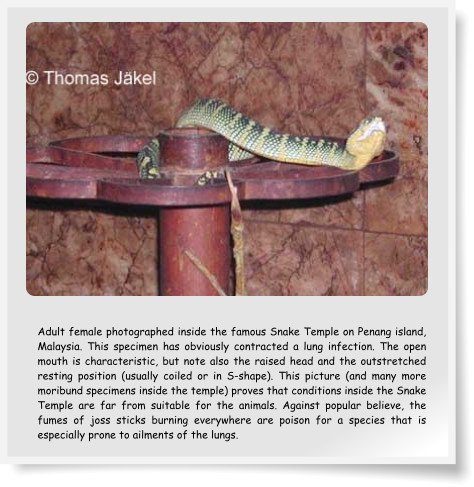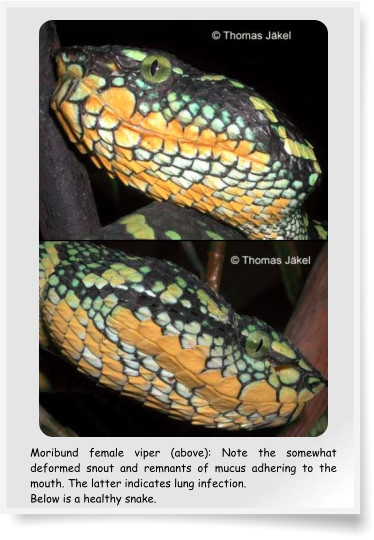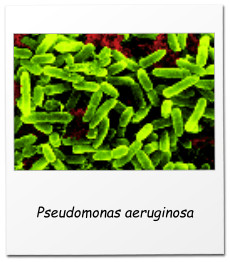

© 2004-2021 Thomas Jäkel

Health Problems
Wagler's viper can be a problematic species in captivity. This is mainly true for wild-caught adult animals that have suffered stress and dehydration during storage and transport. Any new animal arriving in a collection should be put in quarantine for at least 2 months, and kept under optimum conditions as outlined earlier. Quarantine means also that the keeper restricts his use of tools for handling the animal or cleaning the cage to this particular snake. A separate room is definitively an advantage given the fact that bacterial and viral infections can spread easily among a keeper's snake population. To check the health status of newly arrived animals, they should be placed in a container with water (water level about 2 cm high) for some hours. Dehydrated animals usually start to drink and may defecate after a while. Injection of physiological saline solution (available in a pharmacy) under the skin may also help to recover dehydration. If a viper accepts food (live or freshly killed mice or rats) it is usually a promising sign and further husbandry may not become difficult. If a Wagler’s viper raises its forebody, opens its mouth, and strongly pumps air into the lungs (often associated with a 'click' sound), this is a sign of lung infection. Badly affected animals contain heavy loads of mucus in the lungs and may eventually die of suffocation. Most keepers regard this snake doomed once lung infection sets in, but this must not be the case, especially if only the lung is affected. Antibiotic treatment may help at this stage, but we firmly believe that putting the animal solitary (stress free) under the right climatic conditions (high humidity and fresh air) is the best strategy to save it. Most Wagleris that die in captivity, succumb to lung infections. In our collections, we have found the bacterium Pseudomonas aeruginosa as the main culprit (which was confirmed by various veterinarians), although it was not always entirely clear whether or not it was the only cause of disease. It became clear, however, that excessive mucus production in the lungs was associated with multiplication of the bacterium and that using antibiotics removing P. aeruginosa cured affected snakes. As P. aeruginosa is a wide-spread species being present in almost every corner of this planet, it makes little sense in trying to sterilise cages and the entire environment of snakes. It is much more effective to keep snakes under optimun conditions. If the snakes are kept in a large cage with dense vegetation, special care should be taken that ventilation reaches every corner of the container. It is very dangerous to keep a sick animal infected with P. aeruginosa in contact with healthy snakes. Despite its general presence in the environment, it seems that the bacterium can mutate to forms that are highly pathogenic for the snakes. After I wrote this, a very interesting scientifc investigation was published that strongly support my view: Pseudomonas bacteria can sense the immune status of its host and change its virulence accordingly. Once an infected animal becomes a carrier for such a pathogenic population, healthy Wagleris in the same room may become infected and ill very fast. When we transferred pathogen- free healthy Wagleris into a room which contained sick animals, the newly introduced animals (with no previous history of disease) became ill and some of them died. Aggressive P. aeruginosa infections usually spread through the whole body, and may produce visible eruptions under the scales and skin of a snake. They even invade the eyes and may cause blindness. Viral infections like paramyxovirus that can wreck havoc among many snake species are probably not very pathogenic to T. wagleri, as apparently healthy animals were diagnosed as latent carriers of this virus. However, we have experienced sudden losses of seemingly healthy individuals which is quite indicative of viral infection. The best way to maintain healthy populations of Wagler's vipers in captivity is to start with newborn or young animals and not bring them in contact with any other snakes, be it wild-caught or through exchange with other keepers.

- Home
- Wagler's Viper Site (WVS)
- General Husbandry - WVS
- Breeding - WVS
- Health Problems - WVS
- Taxonomy and Phylogenetics - WVS
- Biology - WVS
- Geographic Variability - WVS
- How Females Change - WVS
- Venom - WVS
- Image Map - WVS
- Special: T. laticinctus - WVS
- Special: North Sumatra - WVS
- Special: Video on Mating - WVS
- Special: North Sulawesi - VVS
- Biological Rodent Control - BRC
- Rodent Management Laos - BRC
- Gallery
- Contact
















